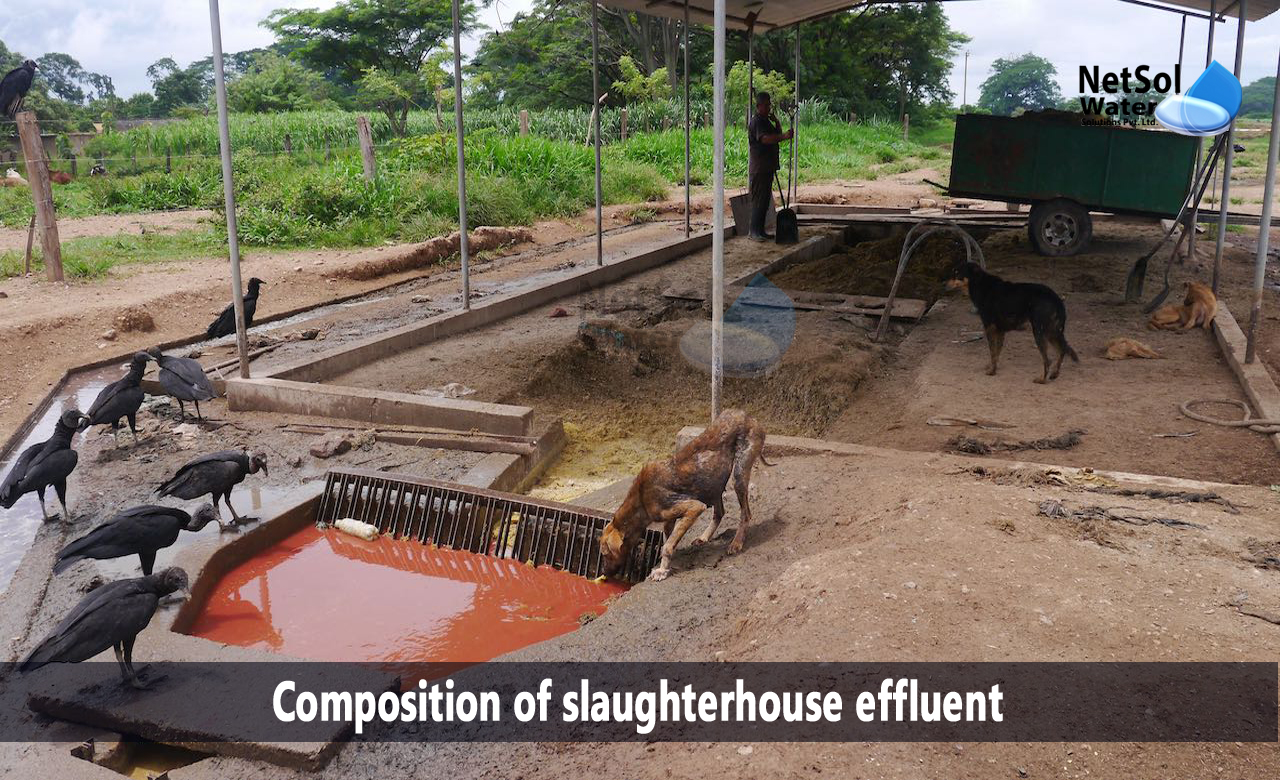There are certain pollution issues associated with the ongoing push to enhance meat production, in order to meet the ever-increasing protein needs of the global population.
Because Good Manufacturing Practices (GMP) and Good Hygiene Practices aren't followed, activities related to the manufacturing of beef/meet might cause pollution. Safety procedures are hardly ever taken into account when animals are transported to the slaughterhouse, when they are killed, and when the hides and flesh are dressed.
Abattoirs utilize a lot of water during processing (slaughtering and cleaning) for hygienic reasons, which generates a lot of effluent.
Let’s learn the composition of slaughterhouse effluent.
Effluent from slaughterhouse
The abundance of suspended solids and liquid waste, as well as the odour creation, are the main environmental issues connected to the abattoir effluent. Because blood, fat, dung, urine, and meat tissues are lost to the wastewater streams during abattoir processing, it has been established that the effluent from slaughterhouses contaminates both surface and groundwater.
Characteristics of sewage from slaughterhouses
SWW has a high total organic carbon (TOC), high total nitrogen (TN), high total phosphorus (TP), high total suspended solids content, and a high biochemical oxygen demand (BOD), chemical oxygen demand (COD), and TOC.
What are the Composition of slaughterhouse effluent?
Blood has the greatest COD of any effluent from abattoir operations, and is one of the principal dissolved contaminants in abattoir wastewater. The amount of wastewater created by allowing the blood from a single cow corpse, to flow directly into a sewer system would be equal to the daily sewage output of 50 humans.
High organic strength, enough organic biological nutrients, suitable alkalinity, a reasonably high temperature (20 to 30°C), and a lack of hazardous material are the main characteristics of abattoir wastes. Anaerobic treatment is highly suited for abattoir wastewaters with the aforementioned characteristics, and the effectiveness in lowering BOD-5 ranged between 60 and 90%. The high quantity of nitrates in the effluent from the abattoir also shows that biological methods could be used to remediate the wastewater.
When discharged to recipient water bodies, nitrogenous wastewater causes unwanted issues such as eutrophication and algal blooms, in addition to an oxygen deficiency. If organic carbon and nutrient sink into the aqueous environment, the level of dissolved oxygen is further reduced. Therefore, it is imperative to manage the discharge of wastewater that is high in combined organic carbon and nitrogen by suitable treatment.
Solubilized organic matter, which is more suited for aerobic treatment, is present in effluents from anaerobic treatment.
Because of this, aerobic treatment systems operate more quickly than conventional anaerobic treatment techniques. They are used increasingly frequently in systems for treating wastewater. Aerobic treatment is frequently utilized as a post-treatment for anaerobic effluents, as well as for nutrient removal because oxygen needs and treatment time are directly related to wastewater strength.
However, biological processes alone do not produce effluents that comply with existing effluent discharge regulations, when treating large levels of organic matter in wastewater. The possibility of resource recovery and high treatment efficacy makes the employment of combined anaerobic and aerobic methods advantageous.
On the other side, certain slaughterhouse effluents include dangerous, bio-resistant, recalcitrant, and non-biodegradable compounds. In order to boost SWW biodegradability and inactivate harmful bacteria and viruses that are still present after biological wastewater treatment, advanced oxidation procedures (AOPs) may be used. As a result, for the treatment of slaughterhouse effluents, AOPs, especially as a post-treatment technique, offer an appealing alternative and supplemental treatment choices to biological processes.
Combination processes for slaughterhouse effluent
It is thought to be both operationally and financially advantageous to treat slaughterhouse effluents, using a combination of biological treatment and AOPs. In order to create high-quality effluents from industrial and high-strength wastewaters for reuse and resource recovery, combined methods combine the advantages of numerous technologies.
For the successful treatment of slaughterhouse effluents, a cost-effectiveness analysis is used to shorten treatment times and lower overall treatment costs.
How can we help?
In India, Netsol Water is a key provider of WTP, WWTP, STP, and ETP manufacturing services, among other services. The business manufactures equipment and is dedicated to offering workable solutions that support the growth of enterprises.
We are dedicated to provide practical assistance, professional guidance, and training to our esteemed clients.
Netsol Water is Greater Noida-based leading water & wastewater treatment plant manufacturer. We are industry's most demanding company based on client review and work quality. We are known as best commercial RO plant manufacturers, industrial RO plant manufacturer, sewage treatment plant manufacturer, Water Softener Plant Manufacturers and effluent treatment plant manufacturers. Apart from this 24x7 customer support is our USP. Call on +91-9650608473, or write us at enquiry@netsolwater.com for any support, inquiry or product-purchase related query.



